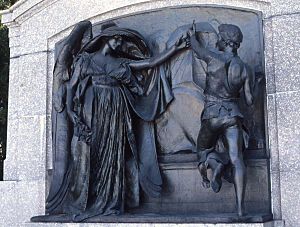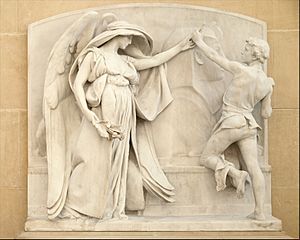Death and the Sculptor facts for kids
Quick facts for kids Death and the Sculptor |
|
|---|---|
 |
|
| Artist | Daniel Chester French |
| Year | 1889 |
| Type | bronze sculpture |
| Dimensions | 250 cm × 76 cm (100 in × 30 in) |
| Location | Boston |
| 42°17′52.3″N 71°6′27.2″W / 42.297861°N 71.107556°W | |
| Owner | Forest Hills Cemetery |
Death and the Sculptor is a famous bronze sculpture. It is also known as the Milmore Monument or The Angel of Death and the Young Sculptor. This artwork is one of the most important pieces created by the sculptor Daniel Chester French.
The sculpture was made for the grave of the Milmore brothers in Forest Hills Cemetery in Jamaica Plain, Boston, Massachusetts. The brothers were Joseph (who lived from 1841 to 1886), James, and Martin Milmore (who lived from 1844 to 1883). The sculpture shows two main figures. One figure is a sculptor, and the other is a winged female figure representing Death. Death gently stops the sculptor's hand as he works.
The Milmore Brothers
The Milmore brothers moved to the United States from Ireland in 1851. Joseph became a stone carver, and Martin became a sculptor. They often worked together on art projects. One of their most famous works is the granite Sphinx (made in 1873). You can find this Sphinx at Mount Auburn Cemetery.
Creating the Sculpture
Daniel Chester French was asked to create this memorial in 1889. It was officially dedicated in 1893. The sculpture shows the Angel of Death gently taking the hand of a sculptor. The sculptor is shown working on a sphinx figure. This sphinx looks very much like the one the Milmore brothers created.
When a plaster model of the sculpture was in Paris to be cast in bronze, it was shown at several art exhibitions. One of these was the Salon de Champs de Mars. There, it won a third-class medal. This was a big honor, as it was only the second time an American artist had received such an award from the Parisian art world.
The design around the sculpture changed a few times. First, architect C. Howard Walker designed it. Later, Henry Bacon, who often worked with French, redesigned it in 1914. Finally, in 1945, a new design was made by a Boston company called Andrews, Jones Boscoe and Whitmore. At that time, the sculpture was also moved to a new spot.
The bronze part of the sculpture was made in Paris by the Gruet Foundry. Daniel Chester French and the Milmore family decided to make four other copies of the sculpture. These copies went to museums in Chicago, Philadelphia, Boston, and St. Louis. The plaster copy in Chicago was shown at the World's Columbian Exposition. It received very good reviews there. Sadly, that plaster copy was destroyed in 1949.
In 1917, another version of the artwork was made. This one was carved from marble for the Metropolitan Museum of Art in New York. The Piccirilli Brothers carved it. They were known for carving almost all of Daniel Chester French's marble sculptures.
See also
 In Spanish: La muerte y el escultor para niños
In Spanish: La muerte y el escultor para niños


